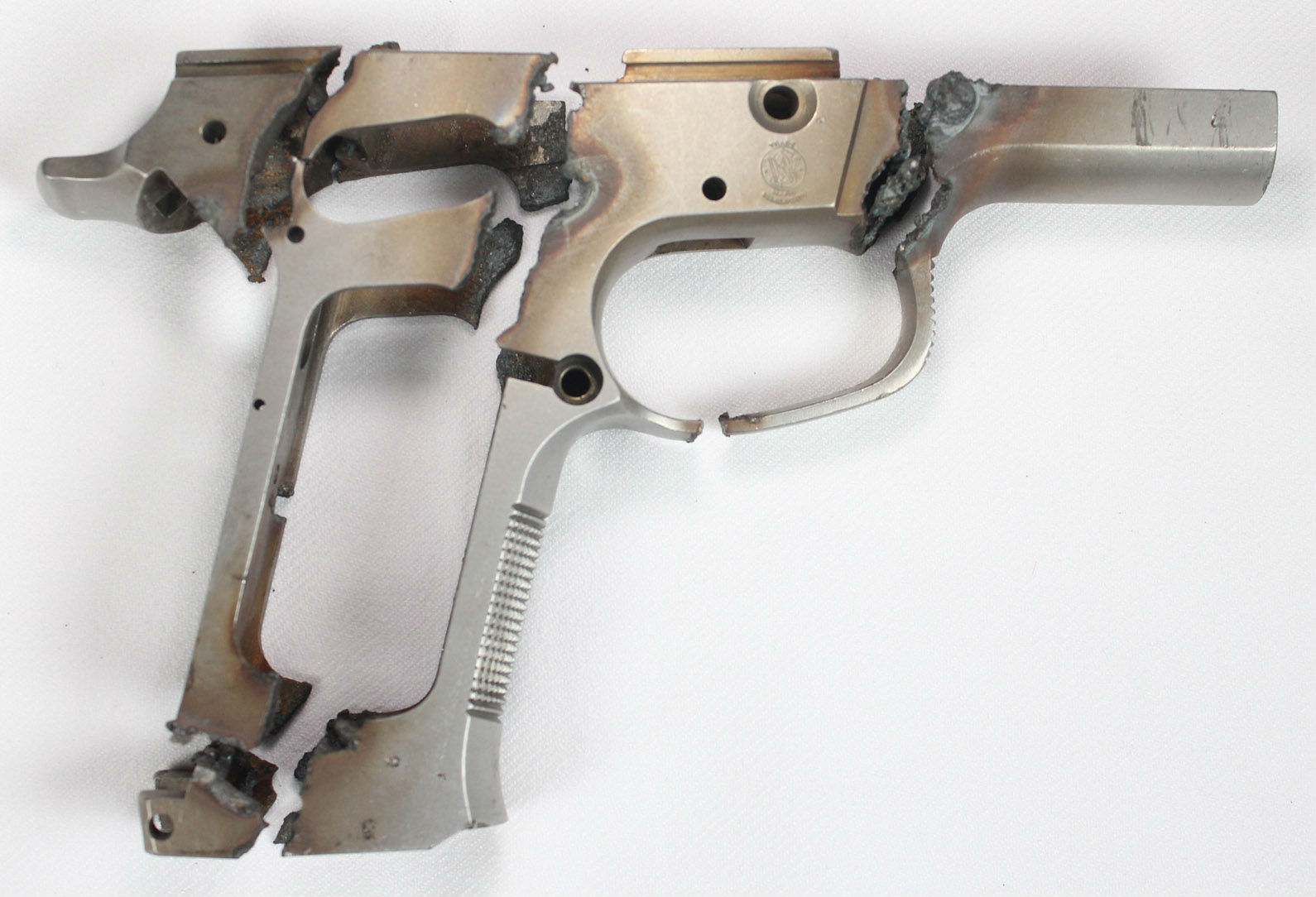By John Krupa III
The Sandy Hook school shooting shocked the very psyche of this nation. I was numbed by its impact, and as a father of two grade school children, it was heart breaking to even imagine what those parents had to endure in the loss of their children.
As the nation mourned, my feelings quickly turned to anger as I began to analyze the incident. I began to visualize as an Immediate Action / Rapid Deployment (IARD) trainer what possible law enforcement (LE) response solutions could have resolved this situation without loss of life. My conclusion was – none.
Since the shooting, school administrators and law enforcement agencies across the country have become overwhelmed with the task of developing more effective measures to prepare school personnel on how to respond to active shooter incidents.
Where do we start?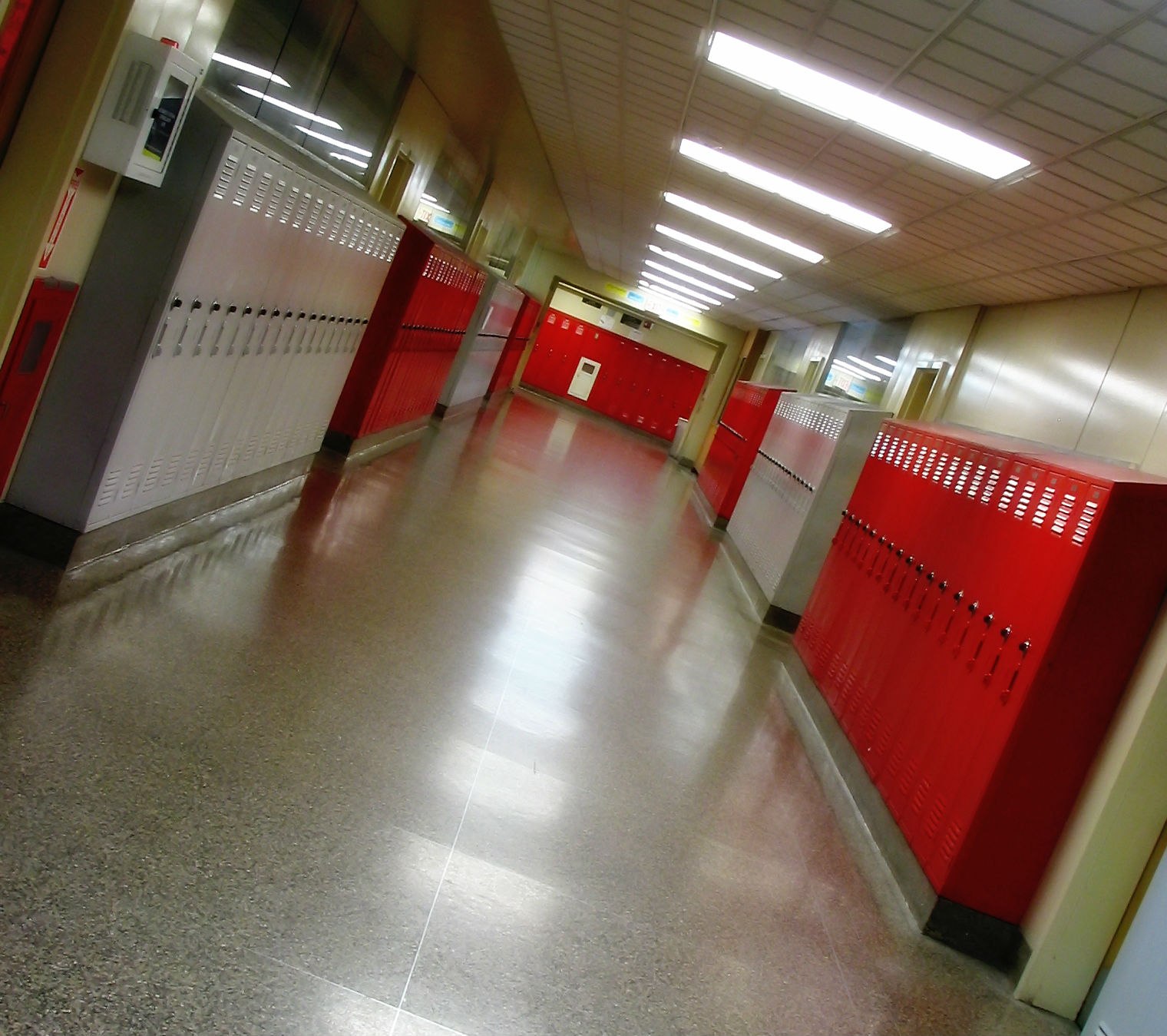
To find the answers to this question, we need to look at the commonalities among previous school shootings from Columbine to Virginia Tech. A close inspection will show that many of the same circumstances existed in just about all of these incidents.
Here are some common traits in many of these incidents:
- The shooters were aware that teachers and faculty were unarmed. (In some instances, “Gun Free Zone” signs were posted outside the school.)
- The shooters were aware of the “lock down” procedure and knew that children would not be evacuated or removed from the scene, but instead, would be herded into classrooms behind locked doors.
- The shooters were aware that law enforcement would eventually respond and knew that they only had minutes to inflict casualties before LEO’s would arrive on scene.
- The shooters had predetermined that they would not allow themselves to be captured alive and that they would commit suicide to avoid contact with LEO’s.
- Specifically, in the Columbine incident, the shooters attempted to buy more time to “hunt and kill” people by planting improvised explosive devices and incendiary devices to impede LE response.
- Also, in the Virginia Tech incident, the shooter chained and barricaded the doors to the building he was in to, again, buy more time to “hunt and kill” people.
What have we learned from these incidents?
In analyzing these gruesome incidents, particularly Columbine, Virginia Tech and now Sandy Hook; unarmed teachers, professors and faculty members were summarily executed when they attempted to resist or confront the shooters.
Many good people – adults on scene at the initiation of these incidents – who tried to do the right thing (unarmed) and protect children and students from being massacred, did so at the expense of their own lives!
So the question that needs to be asked is – “Who really is the first responder?” Is it the LE officers arriving on scene minutes later to handle the situation, or is it the adults capable of taking action that are actually on scene when the incident initiates?
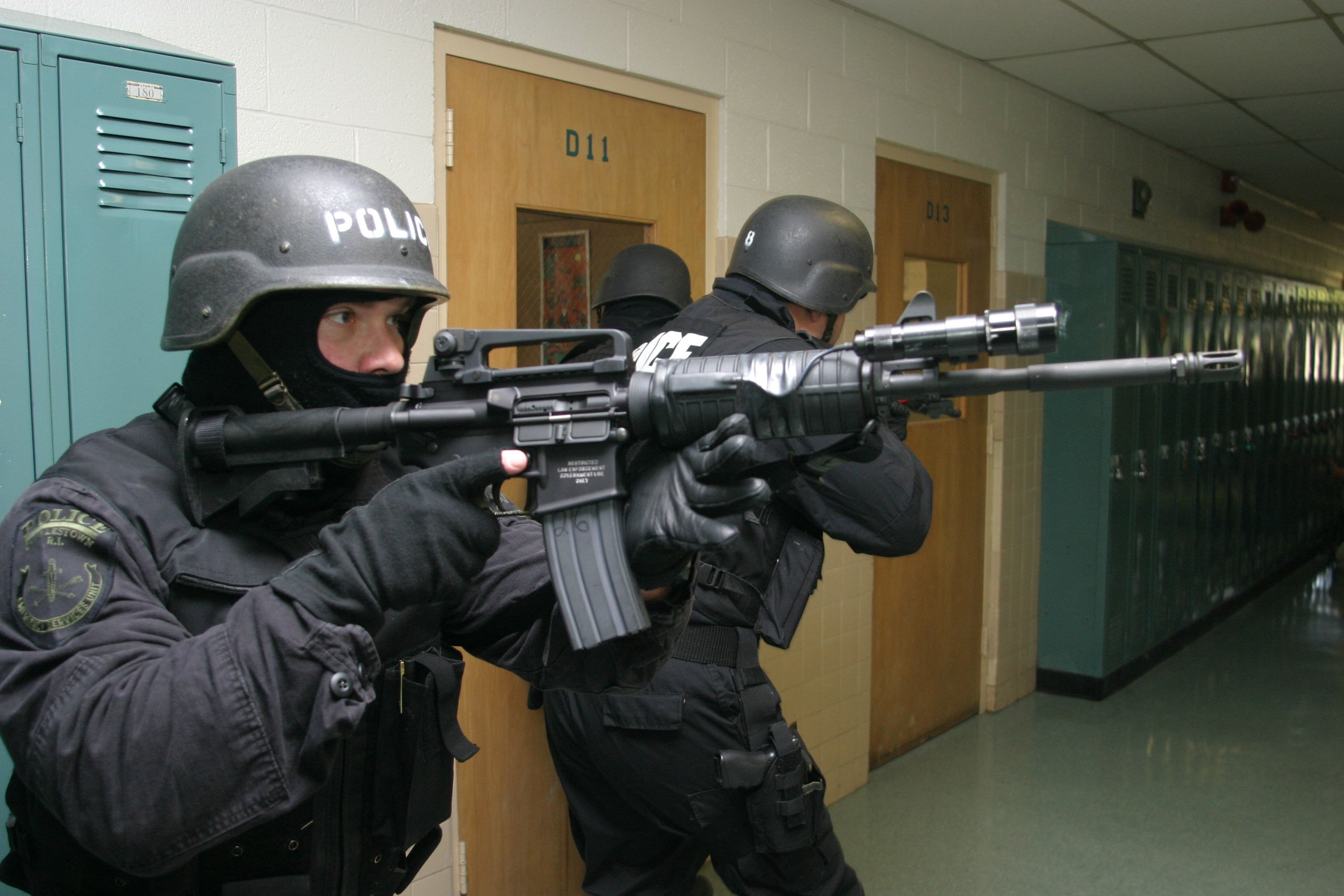 Maybe we as law enforcement officers need to reevaluate our IARD strategies and reconsider other solutions in defining who the first responder should be.
Maybe we as law enforcement officers need to reevaluate our IARD strategies and reconsider other solutions in defining who the first responder should be.
In retrospect, what if these very same teachers, professors, and faculty members that ran to the gunfire in these incidents were properly trained in the use and application of handguns for personal defense? What if these “first responders” were trained in basic IARD concepts so they could react accordingly and take the appropriate actions to stop the active shooters before they could inflict casualties?
Something has to change! People can’t wait anymore for an LE agency to receive a 911 call of shots fired in a school, dispatch that call to units in the area, and then have it take precious minutes for officers to respond and deploy while the shooter indiscriminately executes his victims. We’ve seen this reactionary response repeatedly in these incidents, and it’s just not working!
Thousands of officers across the country, including myself, have been trained in IARD tactics. I run the officers at my agency through an eight-hour in-service IARD training program annually, and it’s just not enough. The time has come where we need to look beyond reacting to school shooting incidents and find a way to have first responders on-site, ready to go when an incident starts.
Where do we go from here?
Since Sandy Hook, I’ve had many discussions and debates with other officers and trainers from various LE agencies on how to resolve this issue and here are some of the solutions that have been brought up in these conversations.
School Resource Officers (SRO) – The knee-jerk reaction after a school shooting incident is always to put police officers in the schools or hire campus police.
The problem with this solution is budget cuts and man power shortages just won’t allow LE agencies to provide enough personnel to adequately cover all the schools in all the school districts. Think about how many schools are in your school district and ask yourself, where will those officers come from?
Also, because of the thin blue line, each school will be lucky if they have one officer assigned per school day. Keep in mind that the SRO will only be there during regular school hours – 0800 to 1600. There won’t be coverage for after school functions or evening sports events.
There are a lot of holes that need to be filled in this solution process. Grade school, high school, and college students should not have part-time or partial protective coverage – it should be constant. We haven’t even included student coverage for off campus events such as away games or field trips!
Off-duty and retired LEO’s – This is a great idea to resolve the man power shortage issue, but again, where is the money going to come from to fund their payroll budget? Paying off-duty or retired LEO’s at an hourly rate would cost a small fortune, and we’d still have to deal with the coverage issue as discussed above.
Security guards – In addition to the previously expressed concerns, now we’re looking at a cheap “deterrent” and the question is, will they be armed? Having unarmed security guards responding to a shooting incident will have the same results as unarmed faculty – and we’re back to square one.
Armed teachers and faculty – Of all the buzz words that have drawn debates across the country, “armed teachers” has been among the most controversial. While this is nothing new to some school districts in Texas and Arizona, the overall concept, in general, has been met with rigid opposition.
In reality, it makes sense. School districts can have a select group of teachers, professors, and school faculty trained in the use of handguns for personal defense as well as basic IARD tactics in how to respond to and deal with active shooters and how to interact with officers arriving on scene.
Advantages of using armed teachers and faculty:
- There is no need to hire extra personnel, but instead use existing school personnel with more responsibilities.
- There is no need to seek funding or create new budgets, but instead rely on the use of school personnel already on salary.
- School districts can rely on select teachers and sports coaches to provide coverage during and after school activities, sports events (home and away games), and field trips.
- Having more than one armed teacher in a school (possibly two or three at a time) will allow for coordinated first responder engagements of active shooters.
- Allows for use of school personnel that have extensive knowledge of the facility they work in and have a better chance of controlling and dominating terrain.
Conclusion
Armed teachers may not be the answer to every scenario, but having the advantage of trained school personnel on-site and ready to take immediate action is the true definition of first responder!
Ultimately, it’s not a question of “if” another school shooting is going to happen, but when and where? Will we be ready?
As always, stay safe, remain vigilant and fight to win!
John Krupa III
Master Firearms Instructor (ILETSB)
President / Director of Training
Spartan Tactical Training Group, LLC
About John Krupa III
John is an active duty police officer with the Orland Hills Police Dept. (IL.) and has more than 22 years of experience in law enforcement. He has previously served as a patrol officer, rapid response officer, field training officer, and firearms instructor with Chicago PD. He is a graduate firearms instructor from the Secret Service Academy, FBI, DEA, and FLETC. John is founder and president of Spartan Tactical Training Group and has previously presented at training conferences across the country with the AFTE, ASLET, GTOA, IALEFI, ILEETA, ISOA, LETC, MidTOA, MTOA, NTOA, and TTPOA.
For more information about training courses offered by John Krupa, visit his website at www.TeamSpartan.com
The views and opinions expressed in this article are those of the author and do not necessarily reflect the official position of Action Target as a company.
![]() target line and even filmed a brief endorsement from Michael Bane. Watch it here:
target line and even filmed a brief endorsement from Michael Bane. Watch it here:






 The sand or dirt berm is the oldest and most basic type of bullet trap. It uses the mass of the berm itself to stop and store bullets, and on outdoor ranges it can literally be the side of a mountain. On indoor ranges however, some type of structure or barricade is used to support the berm and hold back the sand.
The sand or dirt berm is the oldest and most basic type of bullet trap. It uses the mass of the berm itself to stop and store bullets, and on outdoor ranges it can literally be the side of a mountain. On indoor ranges however, some type of structure or barricade is used to support the berm and hold back the sand.


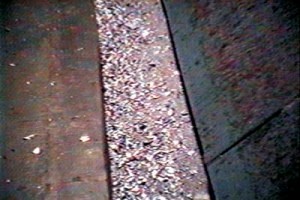
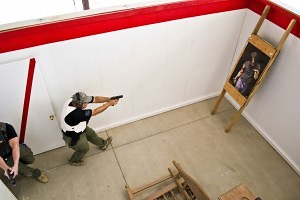
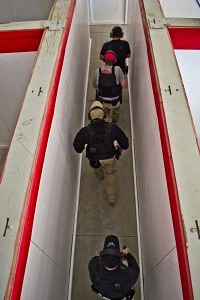
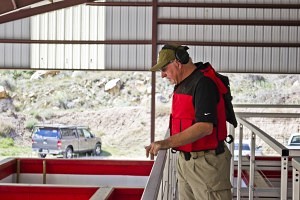

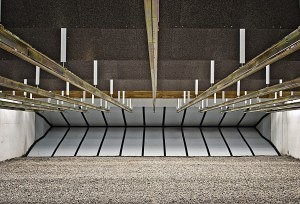

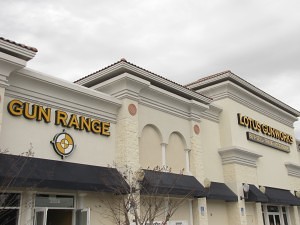
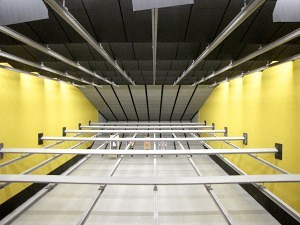
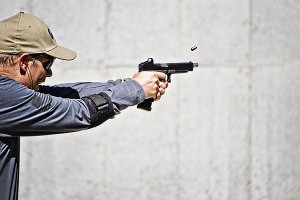
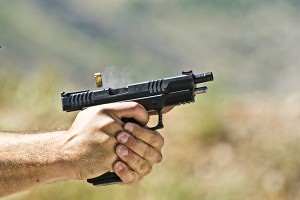 Now, let’s take a closer look at how and why precision shooting works. The muzzle of the pistol must be square with the target to hit the target. Think perpendicular with a very slight upward angle to account for the effects of gravity on the bullet, and horizontally centered. We use our sights as a guide to position the muzzle on the target. The more precisely we align our sights, the closer the muzzle is to square with the face of the target, and the more likely we will hit our desired point of impact, assuming that the pistol is already zeroed. The clear focus on the front sight as viewed through the slightly out of focus rear sight allows us the best chance to position the muzzle square to the target. The target should be out of focus, but its shape should be apparent. As stated above, the eye will automatically find the center of any object.
Now, let’s take a closer look at how and why precision shooting works. The muzzle of the pistol must be square with the target to hit the target. Think perpendicular with a very slight upward angle to account for the effects of gravity on the bullet, and horizontally centered. We use our sights as a guide to position the muzzle on the target. The more precisely we align our sights, the closer the muzzle is to square with the face of the target, and the more likely we will hit our desired point of impact, assuming that the pistol is already zeroed. The clear focus on the front sight as viewed through the slightly out of focus rear sight allows us the best chance to position the muzzle square to the target. The target should be out of focus, but its shape should be apparent. As stated above, the eye will automatically find the center of any object. Since it was founded in 1986, Action Target has had the pleasure of working with some of the greatest innovators in the industry from mechanical engineers to world-renowned law enforcement trainers. Each has left a unique impression and, in some cases, has even shaped the future of the company.
Since it was founded in 1986, Action Target has had the pleasure of working with some of the greatest innovators in the industry from mechanical engineers to world-renowned law enforcement trainers. Each has left a unique impression and, in some cases, has even shaped the future of the company.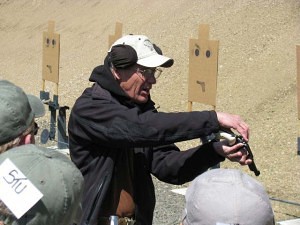

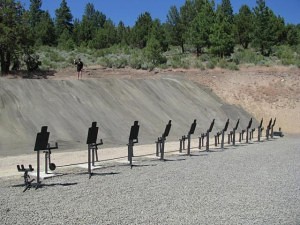
 PROVO, Utah – March 7, 2013 –
PROVO, Utah – March 7, 2013 – 
 Maybe we as law enforcement officers need to reevaluate our IARD strategies and reconsider other solutions in defining who the first responder should be.
Maybe we as law enforcement officers need to reevaluate our IARD strategies and reconsider other solutions in defining who the first responder should be.

